Forget Kim Jong Un — we have a real Olympics horror story for you:
—
UPDATED 2/10/18: The Winter Olympics are here! The last time around, during 13th Dimension’s early days, contributor John DiBello put together this Gold Medal-worthy piece. Perfect time to enjoy it again! — Dan
—
By JOHN DiBELLO
It’s Winter Olympics time! And what better way is there to celebrate this crown jewel of cold-weather sports than to read comics books? Answer: actually watch the Olympics, or maybe go out and do some winter sports.
But when you’re done with those, why not read a comic book about the 1980 Winter Olympics?
Mention those Games to an American sports fan and most will recall the triumphant underdog win of the U.S. hockey team over the Soviets: the amazing “Miracle on Ice.” But do you remember that it was Peter Parker and Bruce Banner who helped bring the ’80 Winter Games its most important victory? Sports Illustrated or ESPN won’t give you that full story.
For that, you’ll need to turn to Marvel Treasury #25: “Spider-Man vs. the Hulk at the Winter Olympics!”
Marvel Treasury Edition was a series of tabloid-sized (10″ x 14″), extra-thick (68-100 pages) comics — “mammoth sized,” as Marvel’s Bullpen Bulletins cheerfully promoted them. Published in Cold War-like competition on the newsstand with DC’s Limited Collectors’ Edition tabloid comics, the series presented classic reprints in a larger size. Those Romita Spider-Man and Kirby Thor pages looked extra powerful on the bigger pages! Some Marvel tabloids inserted new short stories and features alongside the reprints and others adapted movies as diverse as “The Wizard of Oz” and “2001: A Space Odyssey.”
Only two issues of Marvel Treasury Edition, however, presented brand-new, never-before-seen stories of the Marvel super-heroes. The better remembered of these two was issue #28, the second Superman/Spider-Man crossover. The 1980 Winter Olympics was the story springboard for the other: a full-length team-up of Marvel’s two best-known characters at the time — Spider-Man, who had a (short-lived) TV series a few years before in 1977, and the Incredible Hulk, whose CBS show would run on television until 1982.
MTE #25 had “blockbuster” written on it three ways: a worldwide sporting event, Marvel’s top heroes, and a visually impressive tabloid format. The colorful, energetic cover (above) was sure to catch the eye, and the back boasted some early Marvel work by a penciller who was to become one of the top comic artists of the 1980s: Bill Sienkiewicz.
The issue has several big, bombastic double-page spreads. The opening pages depict, against the snowy and serene background of Olympic host city Lake Placid, N.Y., the kidnapping of a champion Soviet figure skater by a quartet of hooded goons. The Adirondack Mountains of upper New York state have no local super-heroes to call their own, so it’s a good thing that news photographer Peter Parker is in the Olympic Village to take photos of the game. Does nobody ever notice that whenever Spider-Man pops up outside Manhattan, Parker is there as well? No. No, they do not.
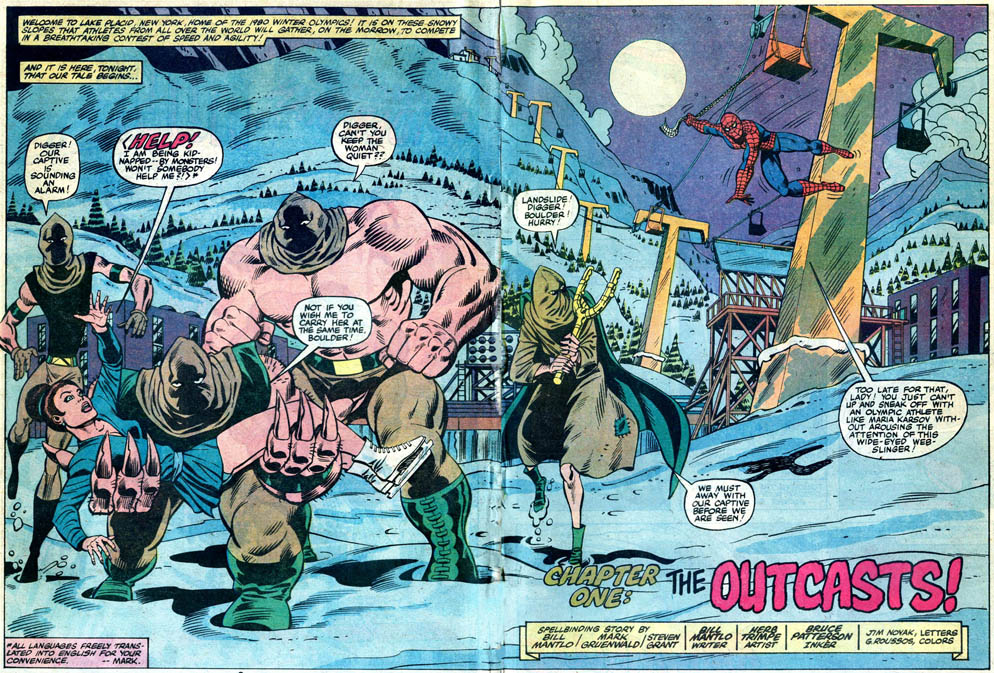
Double-page splash panel of MTE #25: co-plot by Mark Gruenwald, Steven Grant, and Bill Mantlo, script by Bill Mantlo; art by Herb Trimpe and Bruce Patterson; letters by Jim Novak
Right from the beginning the story is heavy on action, and it doesn’t skimp on the exposition, either. We probably aren’t meant to ask how the figure skater was captured yet not discovered until this point while she’s still wearing her skates, but Spider-Man thoughtfully provides us a scorecard of who she is and what’s happening to her. Namely, she’s encased in a giant transparent diamond that disappears below the surface of the earth.
Say, how does she stand inside that thing on her skates? Answer: with Olympian skill.
Soviet skater Maria Karsov is actually the third victim who’s disappeared from the Olympics, as explained by top-seeded downhill skier Brad Rossi, a hitherto-never-seen-before high school classmate of Peter Parker. (He’s never seen after this story, either.) Considering a sports jock like Rossi probably would have hung with the athletic crowd in high school, including Peter’s long-time tormenter Flash Thompson, we should probably be grateful that Brad is not putting ice down Peter’s shirt in this scene. It’s extremely likely too, if you think about it, that Brad’s dated Mary Jane Watson. On the bright side, Brad has the tact not to ask Peter whatever happened to that cute blonde he was dating in college.
Not-quite-meanwhile, in another part of the Adirondacks, perpetual team-up partner and “Marvel’s TV Sensation” the Hulk is battling a team of Lava Men and their lava-tossing trebuchet, which appears to be made out of wood and is quite possibly the most unsuitable material to toss flaming molten stone, much less to be manned by ultra-hot Lava Men.
This failure to reason out their attack plan any further than “let’s toss lava at it!” is probably the reason why, unlike villains Magneto, the Red Skull, or Ultron, they’ve never appeared in a major motion picture. Luckily their as-yet-unseen “mistress” has captured the Hulk in another one of those big glowing diamonds you’ve seen hanging over the heads of your healthy characters in The Sims.
Anyone want to place any money on the possibility that this gigantic jewel can actually keep the Hulk imprisoned? No, I didn’t think so.
The Lava Men’s boss revealed: She’s underworld and underground super-baddie Queen Kala, who’s fought Iron Man and the Fantastic Four and still hasn’t yet learned the lesson that it’s not wise to rile up a superhuman, especially a green one.
She does have a nifty gown, although it’s a little impractical for the weather, and the Hulk is manipulated into a misguided alliance by her sex appeal and her pointy hat. At last, the Hulk’s driving force is something other than grouchiness at wanting to be left alone. Miles away in Latveria, Doctor Doom is slapping his forehead in the realization that he could have successfully kept the Hulk as his ally, if only Doom had dressed up, full Bugs Bunny fashion, in drag.
At last: authentic Olympic action, giving us in comic-book form the thrill of victory and the agony of defeat. Herb Trimpe pencils a two-page spread of the games’ ski jump and the enraptured crowd. That Peter Parker is taking news photographs from inside the spectators’ area instead of being up front with the rest of the press corps is odd but perhaps not unexpected. As we’ve been shown constantly throughout his Marvel Comics adventures, Peter tends to get better photographs if he’s hanging upside-down and shooting on the fly, so maybe he’s never taken Photojournalism 101 and learned that wearing a press badge is good for more than just being able to raid ABC-TV’s craft services table.
Trimpe sneakily inserts lots of guest appearances in the crowd. The Fantastic Four!
Daredevil and Black Widow!
This guy might be Nick Fury!
And this fellow looks nothing like, but apparently is, superstar sportscaster Howard Cosell.
One benefit to penciling a crowd scene: You can insert yourself in it. Here’s a cameo by Herb Trimpe himself and his wife Linda. Two more appearances in a Marvel comic book and they get their own entry in the Official Handbook of the Marvel Universe!
Keep in mind that when the danger and action starts in a couple pages, the Fantastic Four and any other heroes that Trimpe’s shown to be in Lake Placid are absolutely nowhere to be found. I like to think they’re all sitting in the ski lodge by the fire while Johnny Storm tries to woo a cute snow bunny and Ben Grimm slips Tabasco into Johnny’s hot chocolate.
They completely miss skier Rossi being encased in another diamond, which sinks beneath the snow, not to mention Peter swiftly changing into Spider-Man, getting knocked out, and taken beneath the Earth to meet the mystery villain no one expected (unless you looked at the back cover), the Mole Man! Still: hot chocolate, huh?
Surprise! He’s not actually the true villain. The Mole Man’s engaged in a war against Queen Kala for control of Subterranea and its Fountain of Youth that keeps the centuries-old Kala looking like a supermodel. Several panels of exposition later, Spider-Man’s in a reluctant alliance with the Mole Man (don’t you dare call it a team-up). Meanwhile, Kala works to hold the Hulk under her thrall, but the green goliath is a little bit like a dog at suppertime: Disturb him while eating at your own peril. He’ll take that hand right off, Kala!
Kala has kidnapped the four international athletic stars to battle for her against the Mole Man. To ensure their complicity, she’s also nabbed Brad Rossi’s girlfriend and used an “aging ray” to turn her into a crone. Then, she outfits the Olympians with super-advanced futuristic warrior versions of their athletic gear, including “rocket skis” and a “super hockey stick.” I’d like to point out that neither the International Olympic Committee nor any sporting rules book endorses such equipment. In fact, even Darkseid would consider this cheating at sports.
So, you’ve come to this comic book to see thrilling feats of athletic superiority by competitors around the world, and what you got was this:
Advantage: you! But wait, we’ll add more! Let’s toss in Gladiator Hulk…
… and the elevation of the entire Olympic Village on mechanical stilts from underground that lift it into the clouds.
Let’s not stop now to consider the massive human, urban, and environmental damage this would cause — for instance, what happened to the rest of that mountain when half of it flew up into the air? How far did the people in the near end of that building fall when it broke in half? How many of those Monopoly houses collapsed into the pit when it opened up? No need to worry about all that, because, as the caption tells us, “miraculously, no one is killed!” This, then, is the true “Miracle on Ice” of the 1980 Winter Olympics!
Spidey and the plug-uglies from the beginning of the story (who turn out to have been working for Mole Man all along) face off against Gladiator Hulkus Maximus and the Super-Olympians. It’s a battle that will only go to the strongest, the bravest, the most powerful, or perhaps, the one who knows their Br’er Rabbit stories better.
Still, the Olympic athletes strive to play fair, in service to sportsmanship, the spirit of the Olympic Games, and the great athletes of the past. Like hockey legend Bobby Orr, who probably had to face off against a rock-throwing ogre while armed with a hockey stick that launches explosive pucks at his opponent more than once. In fact, several times during the 1976 Canada Cup.
Spider-Man’s battle against the Hulk, on the other hand, probably should be scored not to the Olympic anthem but instead the theme from “The Benny Hill Show.”
It’s a rare comic book where you’re cheering for the Mole Man to win, but record books for the XIIIth Winter Olympiad clearly state that [SPOILER WARNING!] Moley took home the Gold in the Fighting an Ancient Subterranean Queen and Her Cadre of Super-Sports event. This is a good fact to know the next time you’re trying to win the orange “sports” wedge in your next game of “Trivial Pursuit.”
Kala ages back into a crone, Rossi’s girlfriend is restored to youth, and the elevated Olympic Village? The Hulk hammers it back into place. Sports realism at its finest!
All’s well that ends well as Spider-Man reminds us, Spidey Super Stories-style, of the true meaning of the Olympics, swinging off away to … hey, wait, what the heck is that web line attached to?
The inside back cover of Marvel Treasury Edition #25 promises an even bigger sequel, Marvel Super-Heroes at the Summer Olympics. Don’t remember this book? Don’t fret, because, like the USA’s participation in the 1980 Moscow Summer Olympics, it never happened. America and more than 60 nations boycotted the ’80 games in Moscow to protest the Soviet invasion of Afghanistan and the comic was cancelled.
I won’t comment on the eventually ironic political or social aspects of this Olympic boycott, aside from pointing out that when the USSR later boycotted the 1984 Los Angeles Olympics in alleged retaliation, I ate my weight in free McDonald’s cheeseburgers thanks to their “When the US Wins, You Win” game promotion. Thanks, Ray Kroc!
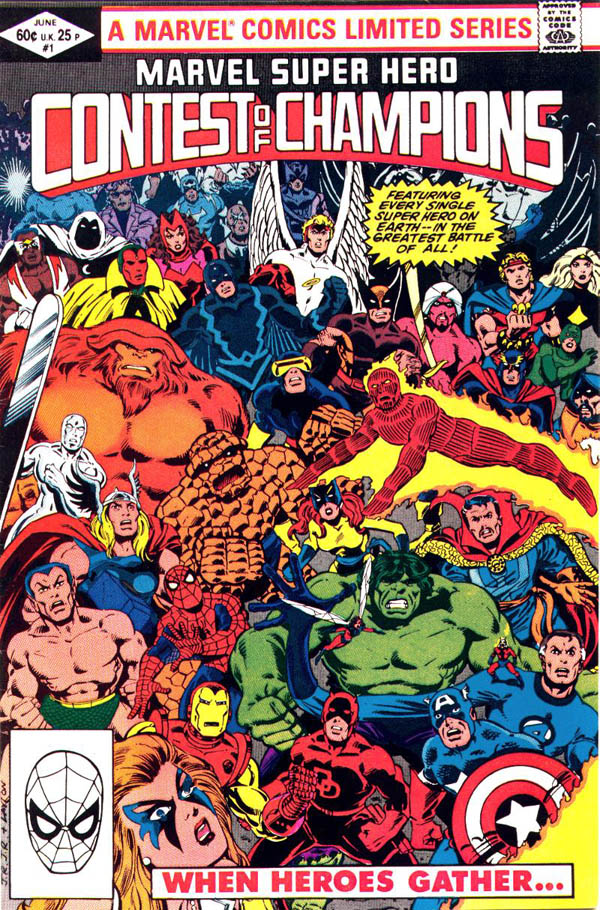
Cover of Marvel Super-Hero Contest of Champions #1 (June 1982), art by John Romita Jr. and Bob Layton
The art and story for the failed Marvel Summer Olympics sequel was revised and eventually saw print in 1982 as Marvel Super-Hero Contest of Champions, guest-starring nearly every single active super-hero and team in the Marvel U, plus a slew of international heroes created especially for the event.
Contest of Champions made comics history as the first all-inclusive company event, as Marvel Comics’ very first limited seriex — and as the story that erroneously awarded the titular contest to the wrong side because the results, a best out of four, weren’t counted correctly. Well, perhaps it’s best that they left the tallying of scores at the Summer Olympics to the professionals, then.
History, at least within the Marvel Universe, will remember the 1980 Winter Games as the astounding victory of the American hockey team, and also that time Lake Placid was elevated several thousand feet above the Earth until the Hulk pounded it back down.
That’s quite enough sporting excitement for one Olympics, thank you.
Leave a comment!

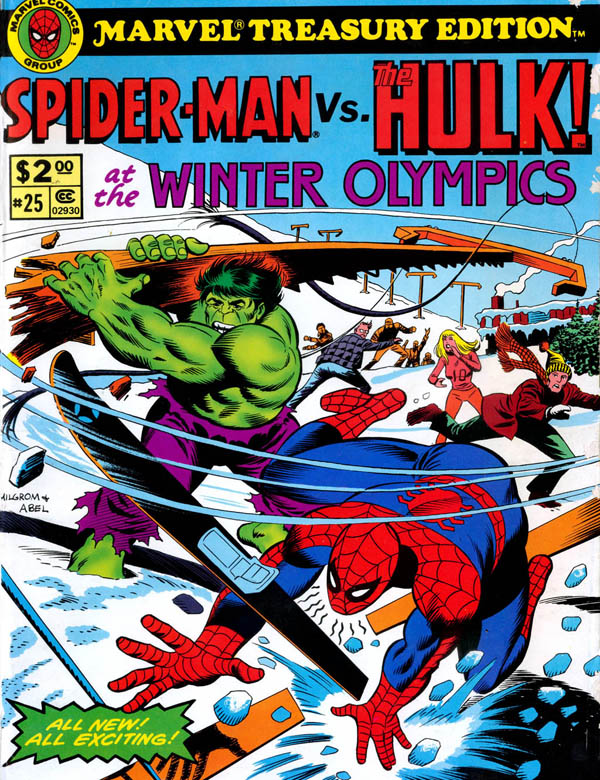
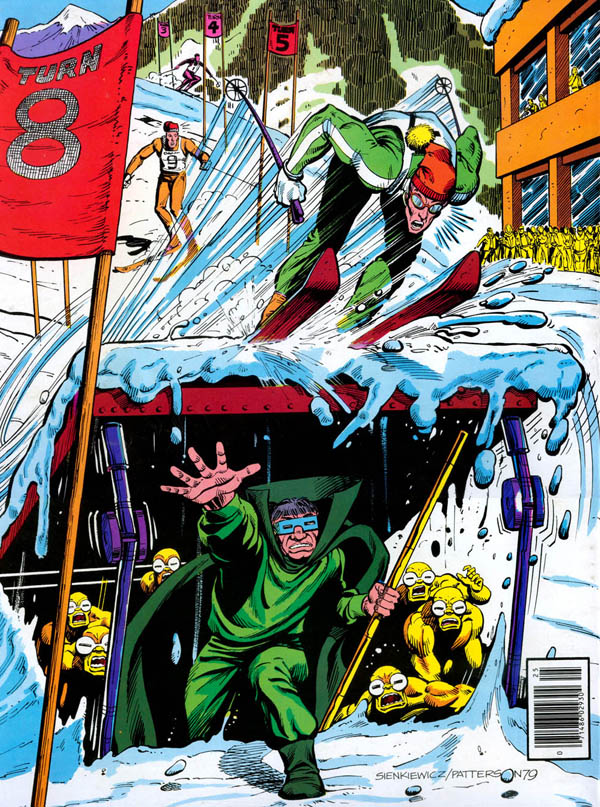
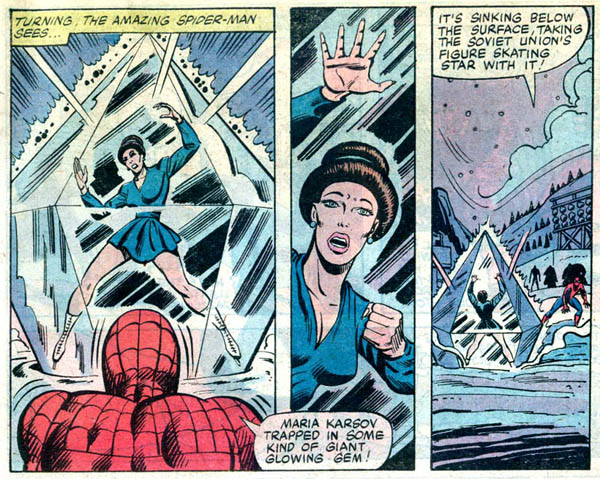
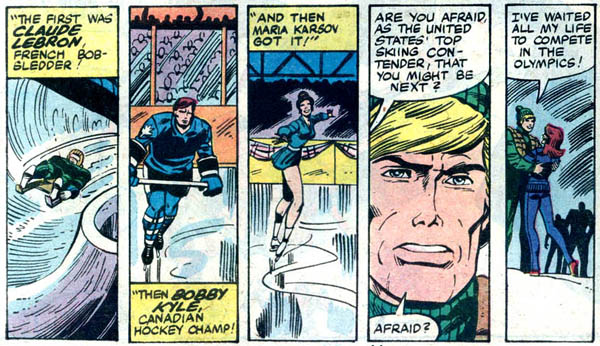
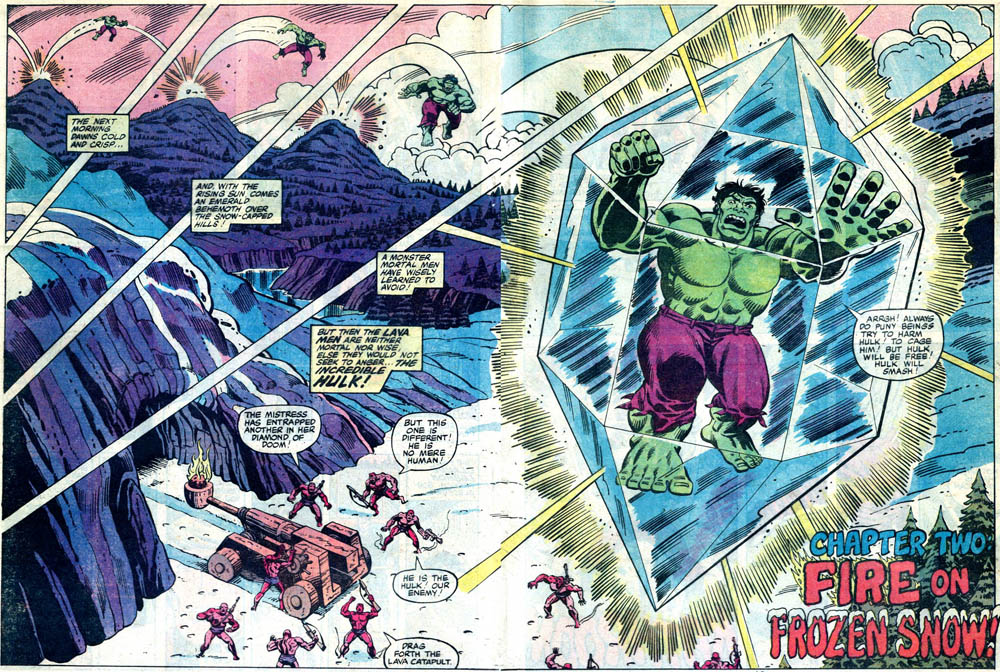
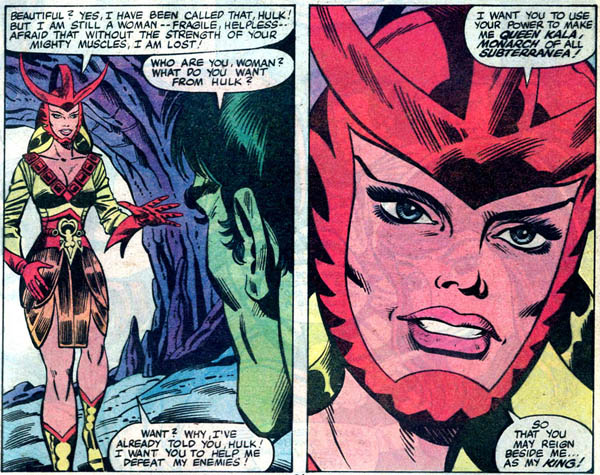
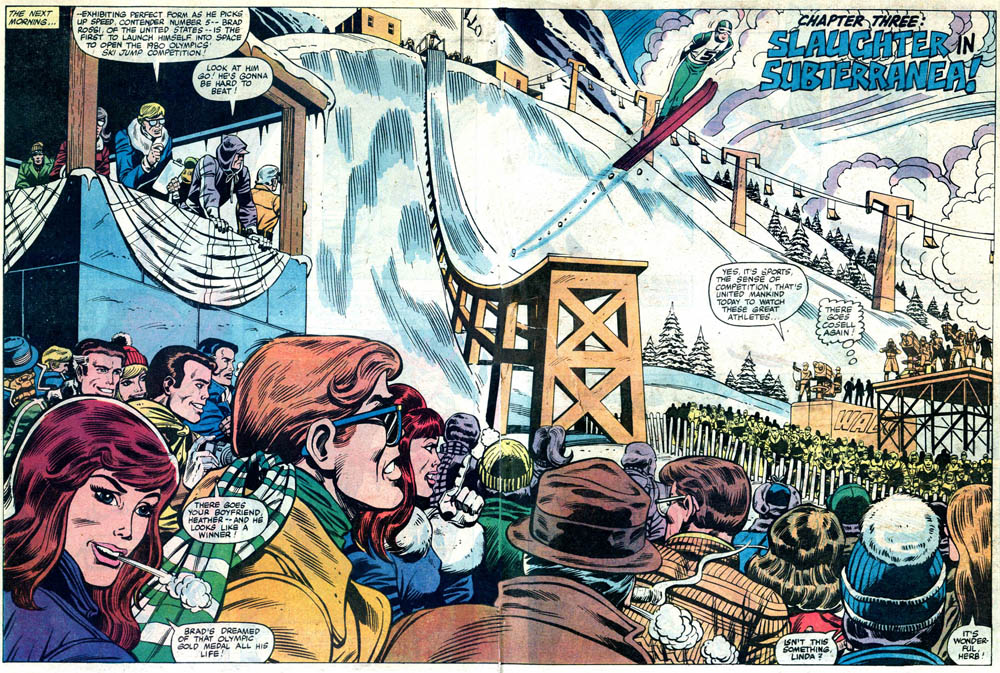
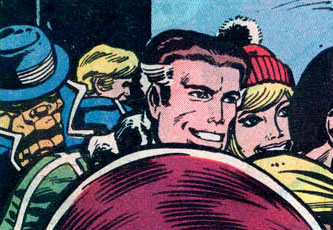
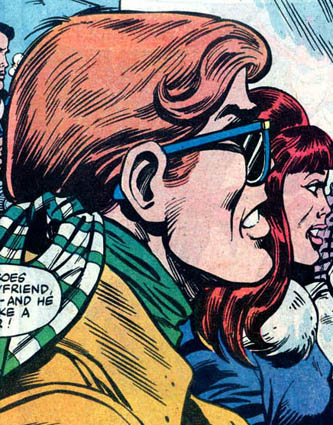
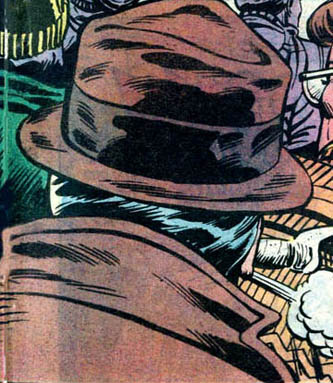
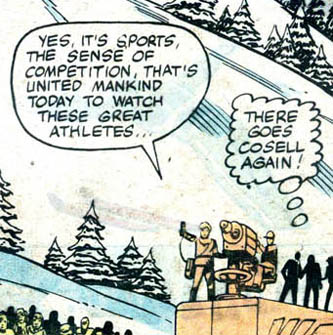
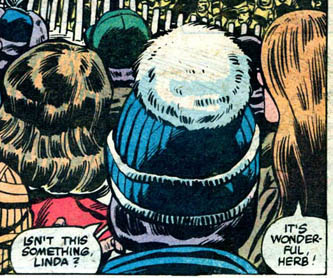
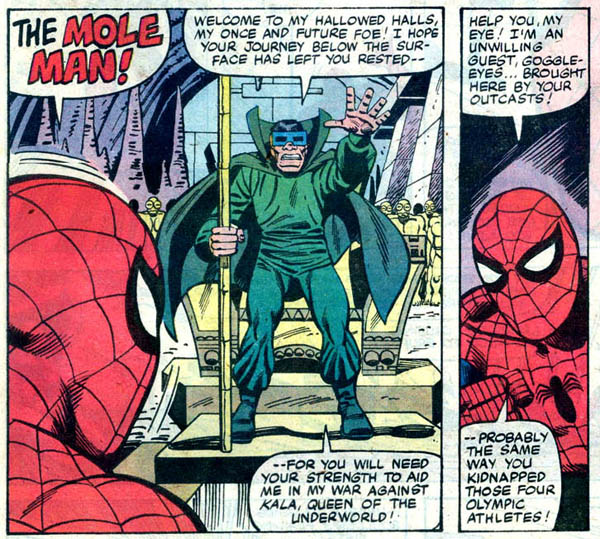
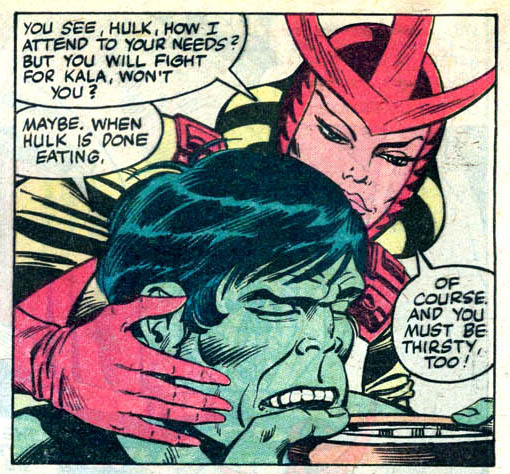
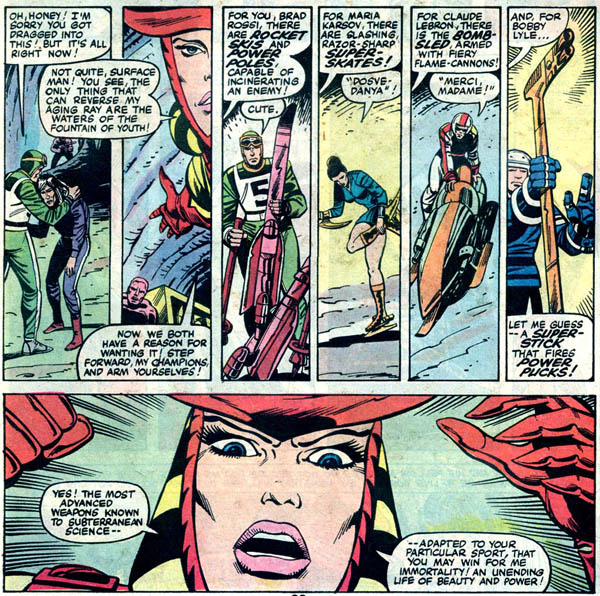
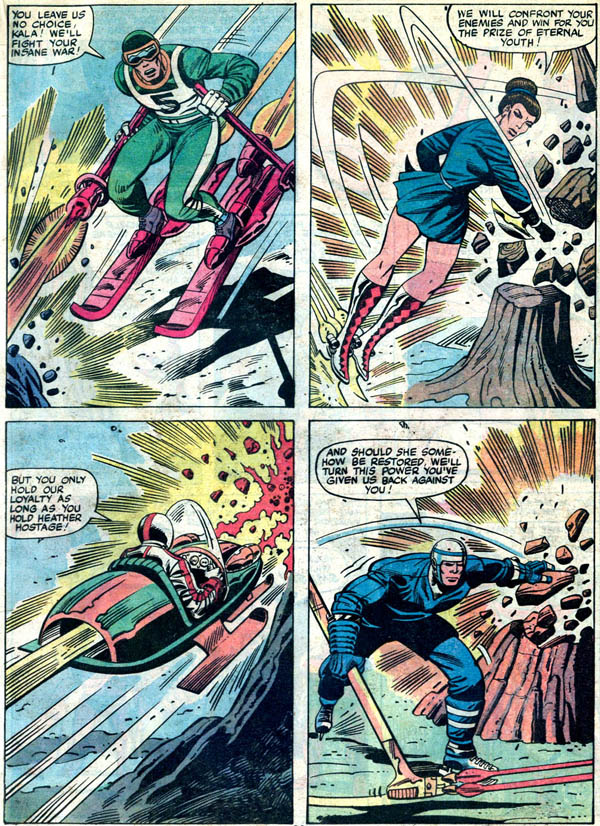
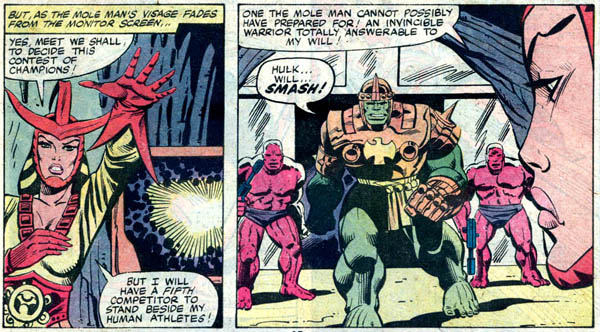
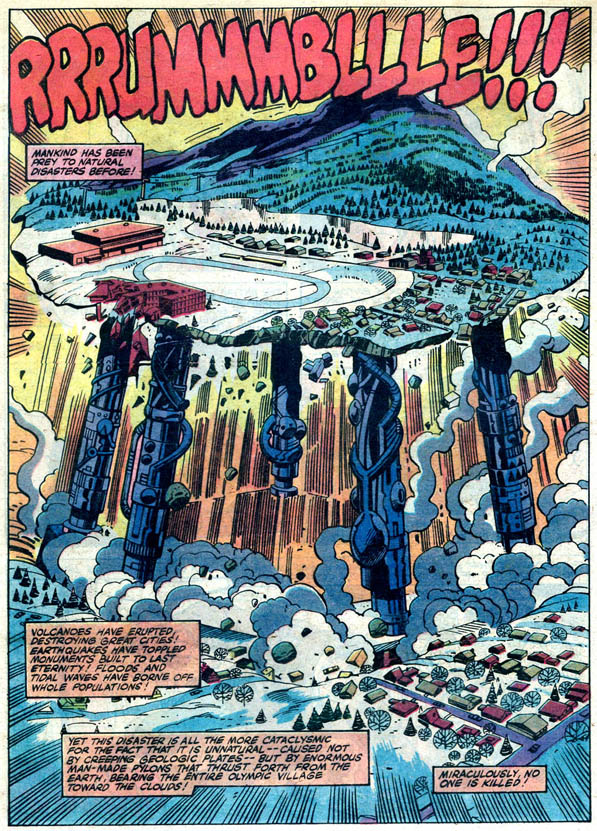
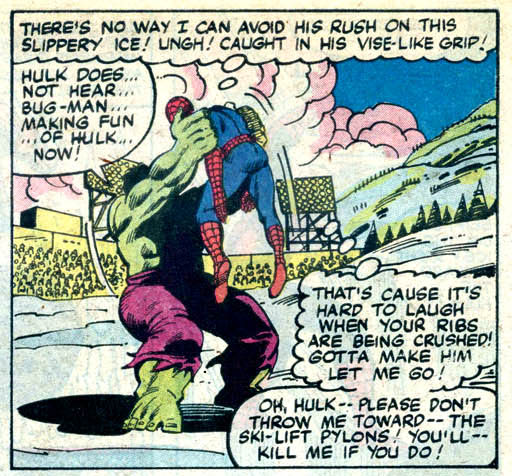
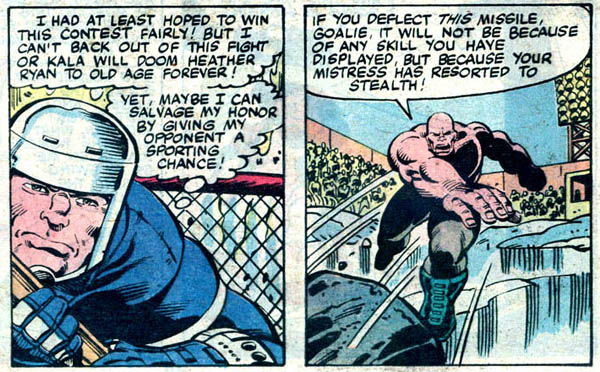
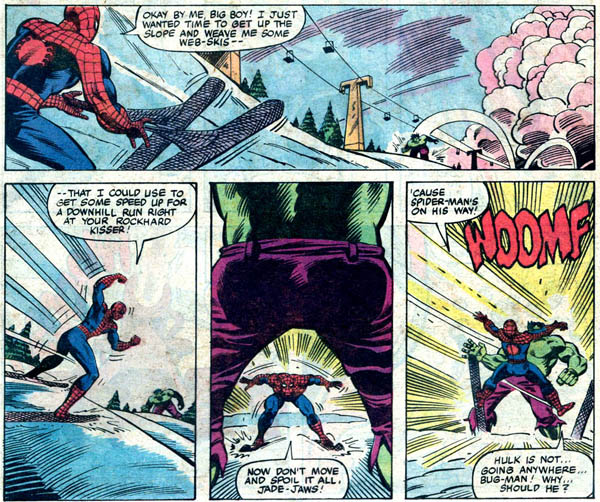
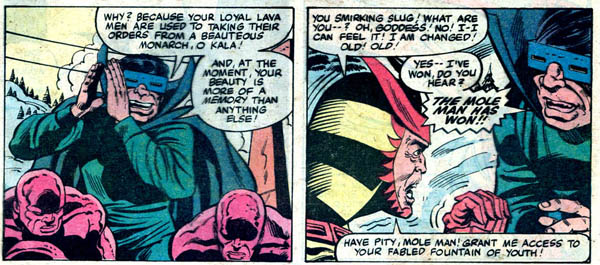
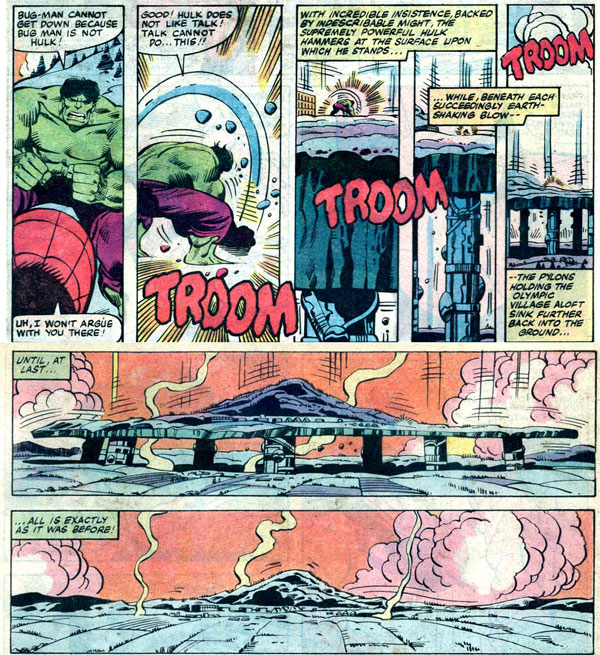
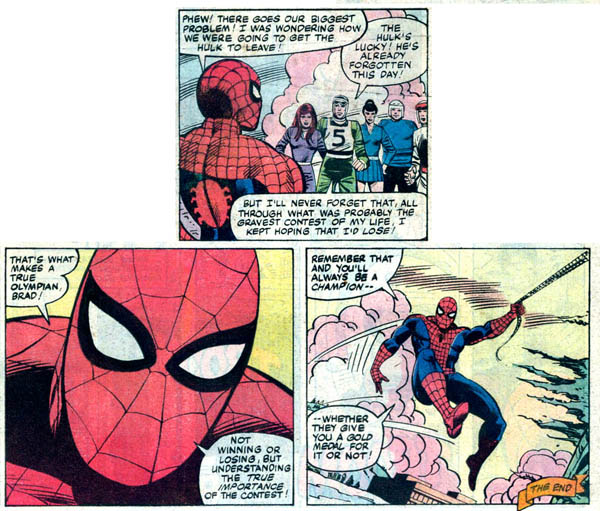
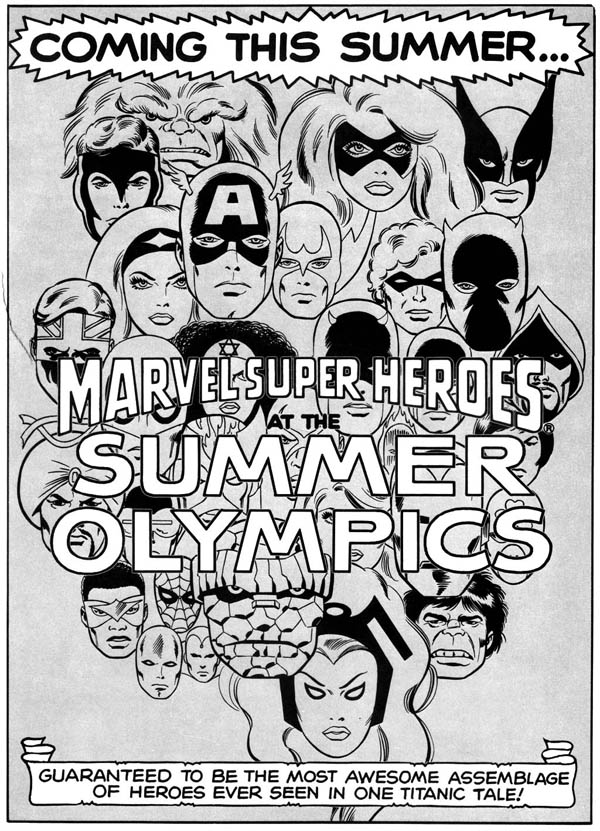
February 14, 2014
Comic are my all time favorite past time.. i prefer reading newspapers or comic in spare time coz both have same topic but newpaper is in real world and comic in virtual lol..
May 22, 2020
That’s what I call pure retro-epicness.